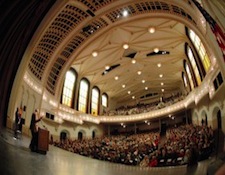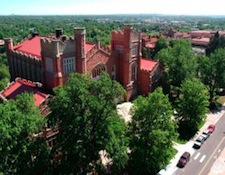It’s the time of year for saving money!

The morning after I returned from the 2012 CES I was up early hanging mic cable at 9:30AM. Going from four days of listening to recorded music to recording a live concert really isn’t such a stretch. The source is better, but the playback set-up isn’t as elaborate.
For Saturday evenings’ live concert recording I used a pair of Scheops Collette mics. One has a hyper cardioid capsule while the other, a figure of eight. I record in M/S (mid/side) and decode the M/S in a Grace Lunatec V3 preamp before sending the analog signal to my Korg MR-1000, which records in DSD at 5.6 MHz. montiroing is done through a pair of Yamaha YST-M7 self-powered speakers as well as several sets of earphones.
In Macky Auditorium I must “fly” the mics, dropping mic cable from the ceiling and using a tieback cord to put the mics into their final position. It is a two-person job. When I started recording the Boulder Philharmonic in 1993 J. Gordon Holt and I used a similar set-up. I’ve been using and refining it ever since. For this morning’s set up I had the help of Fergus Stone, (no relation except brothers by different mothers (and fathers)). He opted for being “down man” so I went up to the catwalks to drop the mic cables and tieback cord.
During the morning set up I had a surprise; first bad, then good. The bad was after climbing up the 3 ½ story circular staircase to the attic I discovered my tie-back rig was gone. After a trip back down I found that it had been replaced with a much spiffier rig that used a baitcasting reel, a stubby firmly attached fishing pole, and a lead weight. It rocked. But I could have done without out the extra round trip up and down the stairs at 6,700 ft. elevation the day after getting back from ‘Vegas.
After the second trip up the stairs I was feeling less than beneficent toward my fellow man, or musician, since I had to contend with a rehearsal in progress while setting the final microphone position. Communication through walkie-talkies only works so well when an orchestra is rehearsing a fff passage. But Fergus and I soldiered on, largely depending on his final say since I could neither hear nor see much up there.

After getting all the gear set up in our recording room, which is up another flight of stairs in an upstairs dressing room, we began listening to the live mic feed. I thought the soundstage and imaging I was hearing from my monitors was good, but when I got home and listened on something more revealing, I was floored by the image specificity, soundstage width, and dimensionality of the recording. Fergus nailed the mic position. On Sunday morning before diving into writing my Absolute Sound CES show report for I edited the concert and made 192, 96, and 44.1 PCM files from the original DSD master. Even the 44.1 version has convincing spatial recreation.
I’m listening to the 192/24 files through Audirvana. I merely drag and drop the 192 files into Audirvana’s playlist and it begins to play them at 192/24 into an Empirical Audio Off-Ramp USB/SPDIF converter. I could use other programs but Audirvana is easy and doesn’t require it’s own custom library to play files. The final piece on Saturday night’s program, Gershwin’s “American in Paris,” images like so precisely I can practically reach out and touch the first chair violinist during his solo. And the percussion section delivers some hits that rattle my pants legs.
Yes, it’s good to be home…





